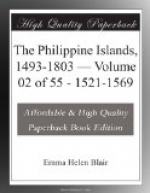learned of gold and mines. On March 5, 1567,
the large frigate was completed and launched, and it
was named “Espiritu Santo.” An expedition
was despatched to the island of Gigantes in search
of pitch for the boats. [76] “What we call pitch
in this region is a resin from which the natives make
candles in order to use in their night-fishing, and
is the same as the copal of Nueva Espana, or at the
most differs from it very little in color, smell,
and taste; but it is very scarce, and occurs in but
few places, and is found with great trouble.”
None was found here, and a boat-load of rice was brought
instead from Panay, On the anniversary of the finding
of the child Jesus in Cebu, the twenty-eighth of April,
one of the two boats that had been despatched to the
coasts of Mindanao under command of the master-of-camp
returned with news of his death from fever, and anger
at an attempted mutiny. Two soldiers who were
supposed to be ringleaders were sent back with the
frigate and the “San Juan” was following
as rapidly as possible. The attempted mutiny
was due to the master-of-camp’s prohibiting any
trading or buying of cinnamon. Martin Hernandez,
a Portuguese, was the leader and the mutiny was smothered
by his hanging. Martin de Goyti was appointed
to the vacant position of master-of-camp, “for
he was entirely trustworthy, and had much experience
in matters of war.” Besides the master-of-camp,
fifteen or sixteen others died, which the physician
declared was the result of eating too much cinnamon.
The new master-of-camp executed two soldiers and one
sailor, who were found to be, after Hernandez, most
concerned in the mutiny.
The “San Juan” was despatched to New Spain
to carry despatches and to beg aid. At the same
time, July 10, came two boats from the Moluccas with
letters to Legazpi from the Portuguese commanders inviting
the Spaniards to their islands. From these Portuguese
it was learned that they proposed a speedy descent
upon the settlement. The Spaniards were but ill
prepared for such a thing. “All this risk
and danger has been caused by the delay in receiving
aid from that Nueva Espana. May God pardon whomsoever
has been the cause of so great delay and so many hardships!”
[77] (Tomo iii, no. xxxix, pp. 91-225). Cebu,
circa 1566. A petition to the king bearing
signatures of Martin de Goiti, Guido de Labezari,
Andres Cauchela, Luis de la Haya, Gabriel de Rribera,
Juan Maldonado de Berrocal, Joan de la Isla, and Fernando
Rriquel, sets forth the following requests: 1.
That ecclesiastics be sent to Cebu, “for the
preaching of the holy gospel and the conversion of
the natives,” as only three of those first sent
remain, namely, Fray Diego, Fray Martin de Herrada,
and Fray Pedro He Gamboa. 2. More men, and arms
and ammunition for five or six hundred men, so that
if the natives will not be converted otherwise, they
may be compelled to it by force of arms. 3. That
due rewards be granted Legazpi for his faithful service.
4. The confirmation and perpetuation of the appointments




